Voice search was introduced by Google in 2011, and back then, it was more of a fun gimmick than something people took seriously. But with big leaps in speech recognition technology, voice search has become a big deal in search marketing.
More people are using their voices to look things up online, find local spots, make buying choices, and much more. When it comes to local businesses, voice search often leads to one clear action: a phone call.
Below, we’ve rounded up the top voice search stats every digital marketer should know to thrive in this voice-driven era.
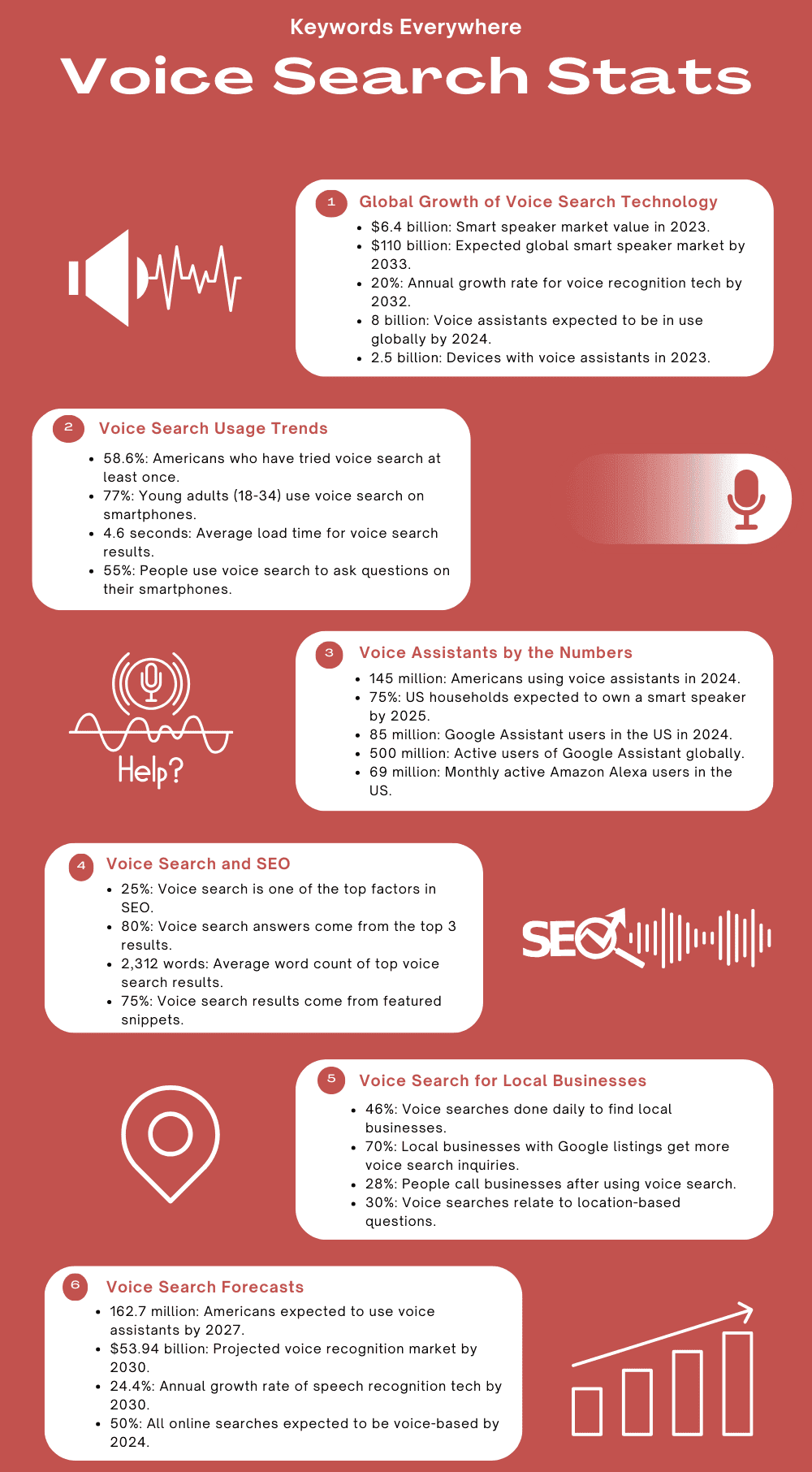
General Voice Search Statistics
Voice search is quickly becoming the standard, changing how we use technology. Here are some important voice search stats that show what’s happening in the industry this year and how people are using voice assistants and smart speakers.
1. In 2023, the global smart speaker industry was worth $6.4 billion and is expected to grow rapidly, reaching $110 billion in the next decade.
2. By 2024, smart speaker sales are predicted to exceed $30 billion, making them one of the top-selling gadgets.
3. The global market for speech and voice recognition is set to grow from $17 billion in 2023 to around $83 billion by 2032, with an annual growth rate of 20%.
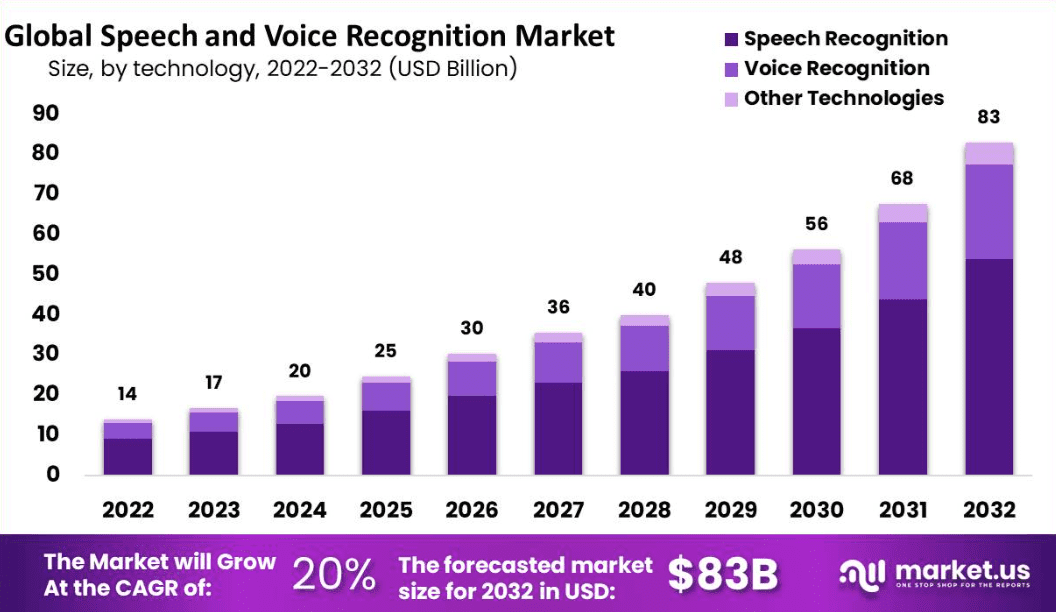
Source
4. Voice search results load in just 4.6 seconds on average—52% faster than regular search results.
5. In the U.S., 58.6% of people have tried voice search at least once, a trend that marketers should pay attention to. Plus, 34% of people without a voice assistant are interested in buying one, which could boost the smart speaker market.
6. Google Assistant is leading the way with over 85 million users in the US this year. Its popularity is expected to increase, reaching nearly 92 million users by 2025. This puts it ahead of Siri, with 86.5 million users, and Alexa, with 77.2 million.
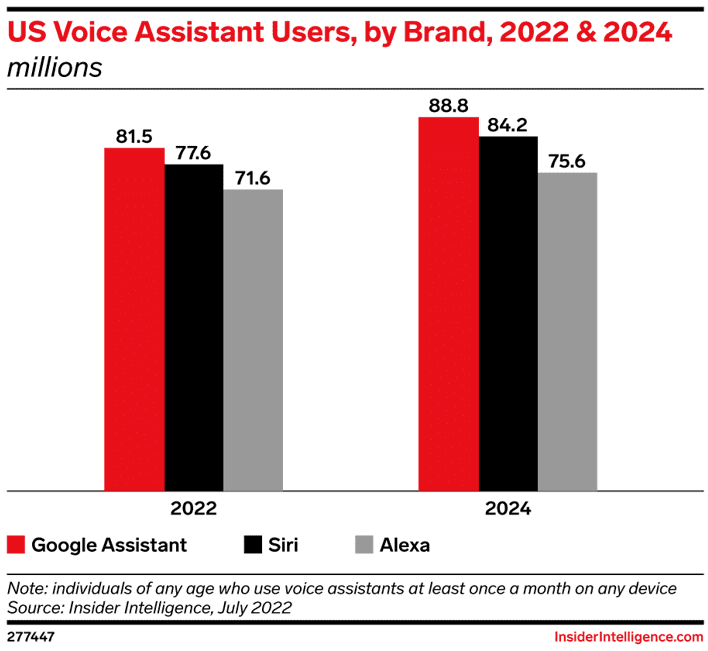
Source
7. In 2018, around 28% of U.S. households had at least one smart speaker. That number is expected to rise to about 75% by 2025.
8. Although voice search isn’t the most popular voice-related activity, it’s still quite common, ranking sixth. Making calls and sending texts are the top two activities.
9. By the end of this year, over 145 million people in the US will be using voice assistants. While smartphones are the most popular devices, smart speakers, connected cars, and smart TVs will also see a boost, gaining over 17 million new users by 2027.

Source
Voice Search Usage Statistics
Are more people using voice search these days compared to before? Absolutely!
Voice search is quickly shifting from something people did occasionally to something they use all the time.
This surge in use is largely thanks to smart speakers like Amazon Alexa, as well as voice assistants built into smartphones, like Siri.
And it’s not just phones—these voice search stats show people are using their voices to search on tablets, cars, and even desktop computers.
10. About 33.6% of US internet users aged 16 to 64 use voice assistants every week, with the 18-34 age group being the most frequent users.
11. While 75% of Americans use voice assistants to check the weather, a whopping 71% use them to play music. Additionally, 68% use digital assistants to search for quick facts, and over half of mobile users rely on AI voice assistants daily.
12. About 90% of people find voice search easier than typing out a search online. Plus, 89% say it’s more convenient, and 87% believe it’s faster.
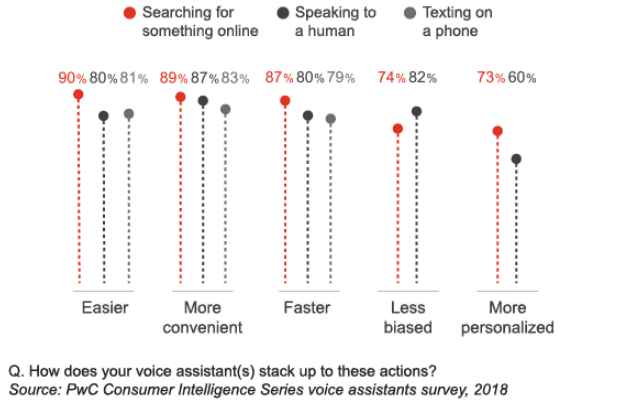
Source
13. 71% of people would prefer using voice search over typing their queries. With so many people feeling that voice search is better, it’s surprising it’s not used even more often.
14. In China, 39.3% of internet users use voice assistants weekly, the highest rate among the surveyed countries.
15. Around 34% of people aged 12 and up own a smart speaker, slightly down from 36% in 2023. Of those smart speaker owners, 43% have three or more devices.
16. In the US, 61.9% of Millennials use voice assistants on any device (mainly smartphones) each month, followed by Gen Z at 55.2% and Gen X at 51.9%. Only 31.5% of Baby Boomers say they use voice assistants.
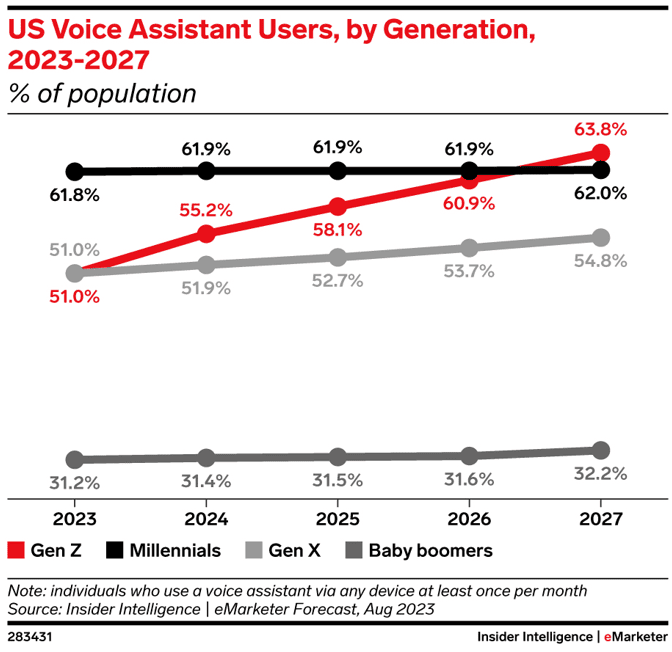
Source
17. Among adults aged 18-34, 77% use voice search on their smartphones, while 63% of those aged 35-54 do the same.
18. 58.6% of Americans have tried voice search at least once, while 41.4% have never used it.
19. About 60% of voice search users say they use it mostly when they are alone, and more than half also use it when hanging out at home with friends.
Voice Search User Statistics
Interacting with voice-enabled devices is becoming a regular part of daily life for many consumers. For brands, it’s crucial to understand which age groups are using voice search and why.
Here are some key voice search stats that shed light on user demographics:
20. About 65% of people aged 25-49 use their voice-enabled devices at least once a day. This is closely followed by younger adults (18-24) and those aged 50 and above.
21. Around 61% of people aged 25-64 say they plan to use their voice devices more in the future, and 57% expect to increase their usage in the coming years.
22. Among wearable device owners, 71% believe they’ll use voice search more often in the future. Tablet and smart speaker users are also optimistic about using voice search more.
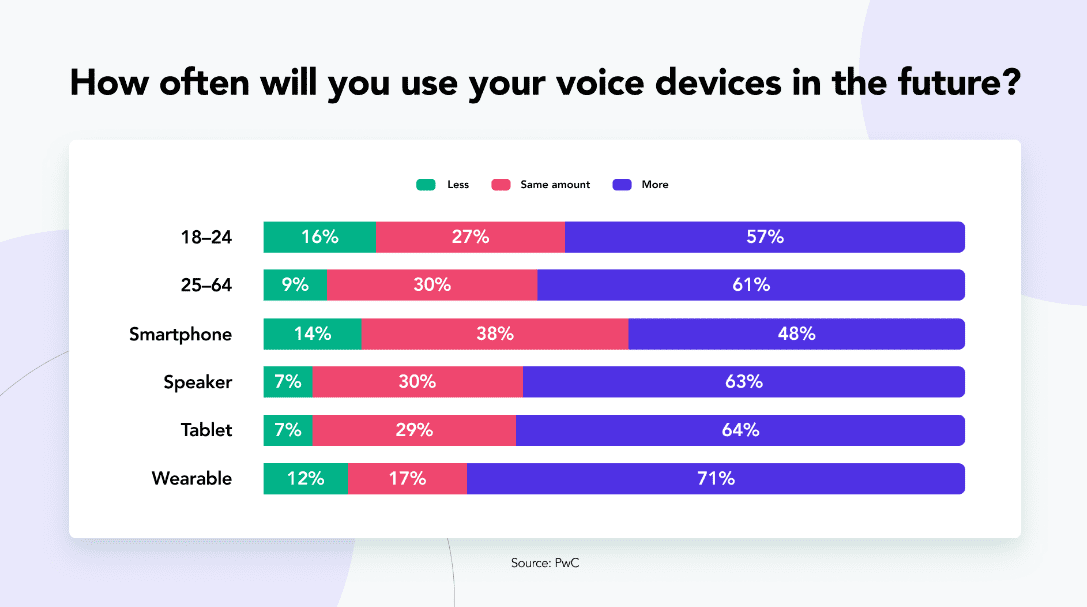
Source
23. A whopping 93% of consumers are happy with their voice assistants. The main reasons they love them are multitasking, getting quick answers, and making life easier.
24. 65% of people with an Amazon Echo or Google Home can’t imagine life without their smart speakers.
25. In 2022, half of U.S. consumers said they use voice search daily. However, usage has fluctuated over the years, with a notable 35% drop in voice search usage in the U.S. from 2018 to 2021, according to The Manifest.
26. By 2027, Gen Z will be the biggest group using voice assistants, with 64% of them using one every month, up from 51% in 2023. However, millennials will still have a slight lead in total users this year, with just over 46 million compared to Gen Z’s 45 million.
27. The most popular use of smart speakers is listening to music, podcasts, and other similar content. According to eMarketer, there are 86 million people in the U.S. using smart speakers each month this year, and that number is expected to get close to 100 million by 2027.
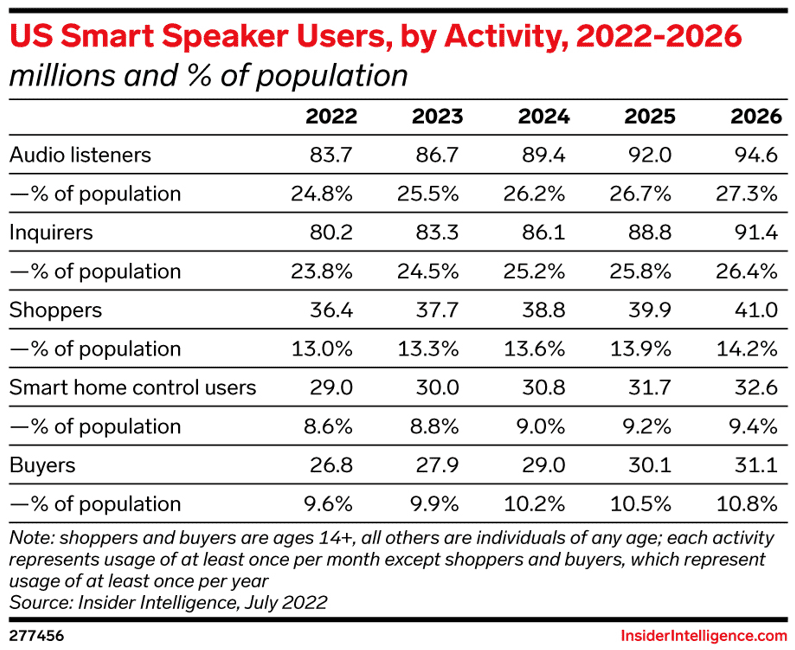
Source
Voice Search SEO Statistics
If you’re in digital marketing, you might be asking, “How can I make the most of the growing voice search trend?”
Don’t worry, you don’t have to guess.
This list of voice search stats on optimization will show you exactly how to take advantage of this trend.
28. Search Engine Journal found that nearly 25% of SEOs think voice search is one of the most important emerging factors in SEO. While voice search was the fifth most mentioned factor, Core Web Vitals topped the list, with 36.6% of respondents considering it the most crucial.
29. On Google Assistant, 80% of voice search answers come from the top three search results. So, to get featured in voice search answers, you’ll need to rank at the very top of the search results page.
30. SEMrush found that over two-thirds of voice search answers on Google Assistant come from specific types of search result features.
31. Pages that rank well for voice searches tend to have about 1,200 Facebook shares and 44 tweets, suggesting that social engagement might also play a role in voice search rankings.
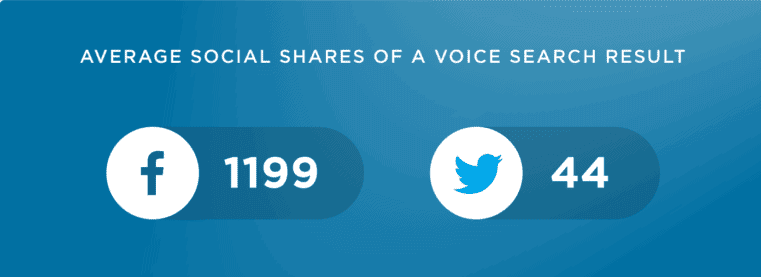
Source
32. Voice search results often come from pages with an average word count of 2,312, indicating that long-form content is favored.
33. More than 70% of websites that appear in Google’s voice search results are HTTPS-secured, suggesting that HTTPS encryption might be an important ranking factor.
34. Nearly 20% of voice search queries come from just 25 keywords, mainly using question words like “how” and “what,” as well as adjectives like “best” and “easy.”
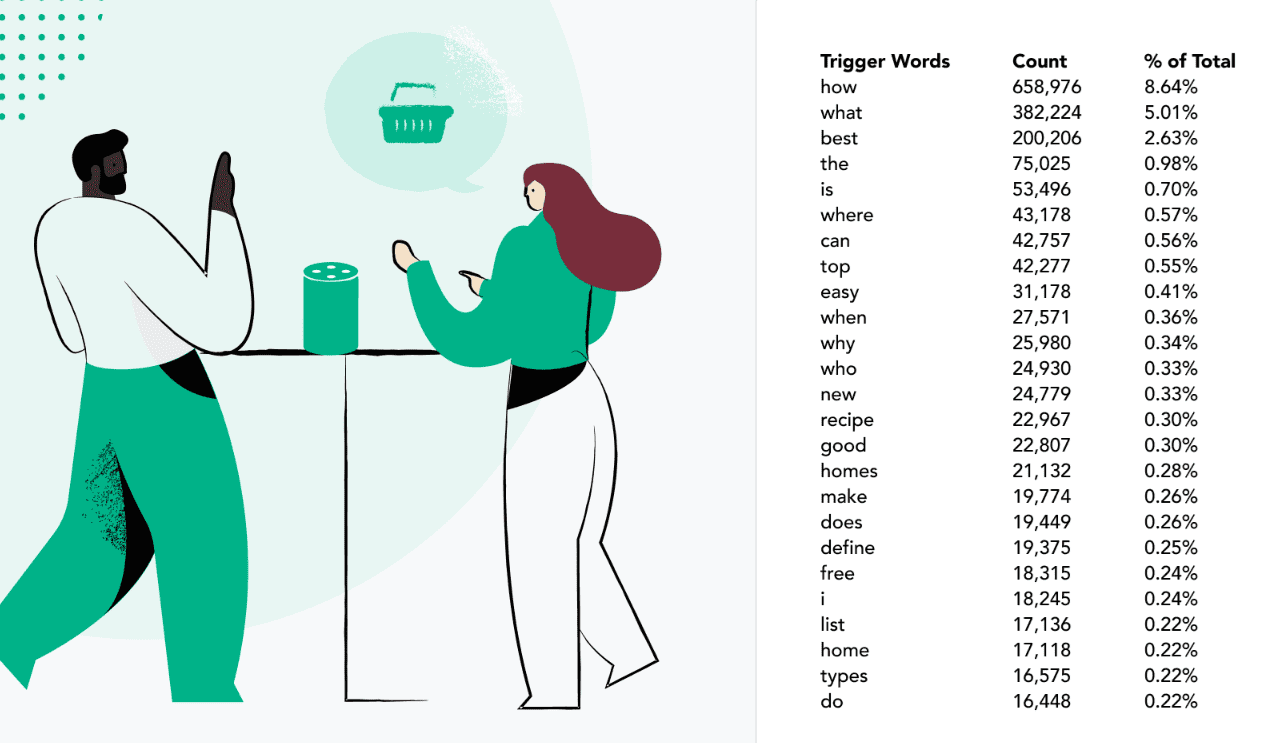
Source
35. After analyzing about 10,000 Google Home search results, Brian Dean found that it takes about 4.6 seconds for the voice search result page to load.
36. About 21% of people use voice search regularly as part of their weekly routine. Since people often use voice search for local information and act quickly on it, focusing on local SEO is crucial.
Voice Search For Business
Voice search is essential for local businesses, with almost 50% of voice searches aimed at finding local info. Businesses that have fully updated Google My Business listings are 70% more likely to get location-based inquiries through voice search.
By optimizing for voice search, you can boost your local visibility, engage more with customers, and provide real-time information.
Here are some important voice search stats that businesses should know:
37. 46% of users perform voice searches daily to find information about local businesses.
38. 58% of people use voice search to get details on local businesses because it’s convenient for those on the go.
39. 51% of people use voice search to find restaurants, making them the most commonly searched business. However, people also use voice search for a wide range of businesses, including hotels, doctors, and insurance companies.
40. According to UpCity, people mainly use voice search for weather updates and local business info. Other popular uses include getting help while driving, looking up definitions, fact-checking, and finding online products and services.
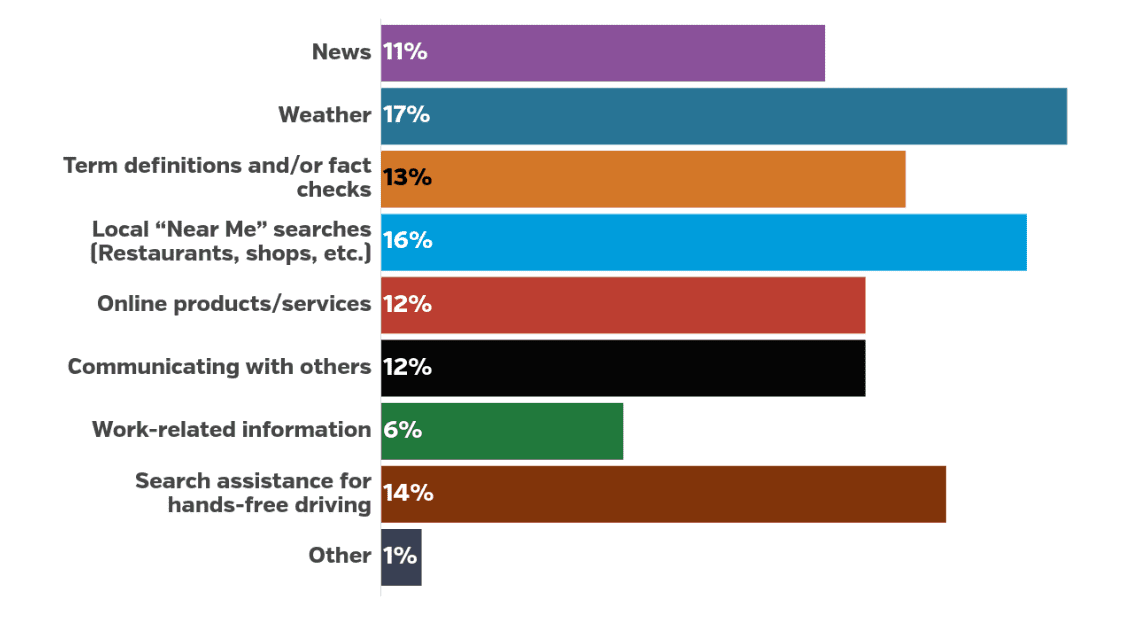
Source
41. 28% of consumers call the business they searched for using voice search, making it the most common follow-up action.
42. 80% of customers think the experience a company provides is just as important as its products and services.
43. 83% of consumers say they need a positive experience to stay loyal to a brand, no matter how they interact with it.
44. 58% of voice search users look up local business details, like directions or opening hours.
45. Keywords Everywhere notes that “near me” searches have a high volume on Google, indicating that local businesses could significantly boost their sales by improving their SEO strategies.
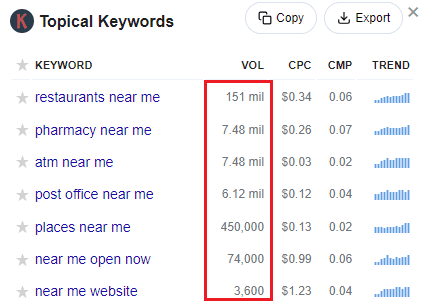
46. Google Assistant pulls local search answers from Google Business and Local Pack features, while Siri relies on Yelp reviews and Apple Maps.
47. 52% of smart speaker owners want to receive information about deals, promotions, and sales from brands, and 48% prefer personalized tips and updates.
48. 56% of users have used voice search on their smartphones to look up information about businesses or brands.
Consumer Preferences & Trends
Voice search is definitely a thing now, and it’s not going away. But why do people use voice search for some things and not others? And which devices do they use the most?
Let’s dive into the latest voice search statistics to find out.
49. One of the top three reasons people buy smart speakers is because they like asking questions without having to type.
50. The most popular devices for using voice assistants are smartphones (56%), smart speakers (35%), and TVs (34%).
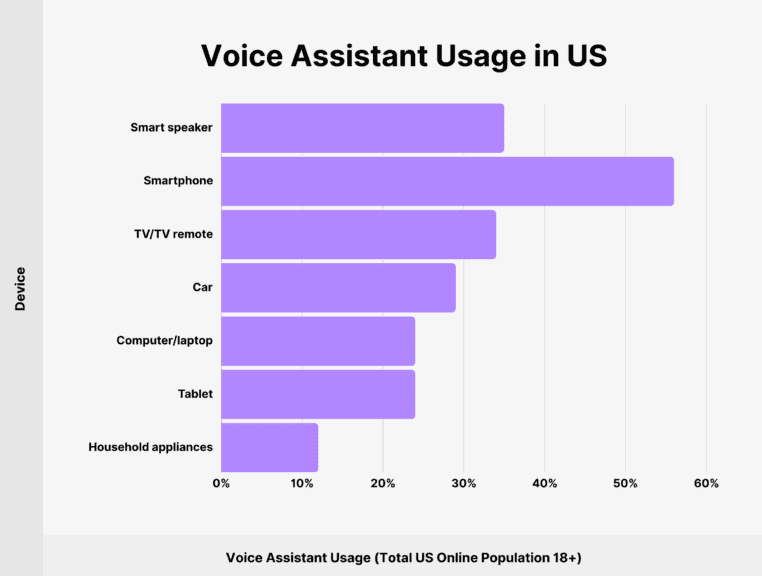
Source
51. On average, smart speaker owners use voice commands for about 11 different tasks each week.
52. 38% of people find voice ads more engaging and less annoying than ads on TV, social media, or in print.
53. 72% of voice search users rely on digital assistants, while 36% use their TV or smart home devices for voice searches.
54. 80% of online shoppers are happy with voice search services, and 39% of them recommend it to friends and family.
55. For 73% of users, accuracy is the biggest challenge with voice search technology. Additionally, 66% say issues with accents or dialects are major obstacles.
56. Over 41% of digital assistant users worry about being listened to or recorded, and 64% have accidentally activated a voice assistant in the past month.
Purchasing Using Voice Search
Every ecommerce business should make sure their online store is ready for voice-based shopping. It’s quick, easy, and works for all kinds of shoppers.
While you might not always be near your smart speaker in the living room, you probably have your smartphone close by.
This convenience means people can shop using voice commands whether they’re at home or out and about.
The following voice search stats highlight how voice shopping is turning into a major money-maker for businesses:
57. About 38.8 million people in the U.S. use smart speakers for shopping-related tasks like researching products or adding items to their cart, making up 13.6% of the population.
58. Around 43% of people with voice-enabled devices use them for shopping. Shoppers of all ages are turning to voice for help with purchases, a trend that grew by 41% in 2018 alone.
59. More than half (51%) of voice shoppers use it to research products. About 22% buy directly using voice, while 17% use it to reorder items.
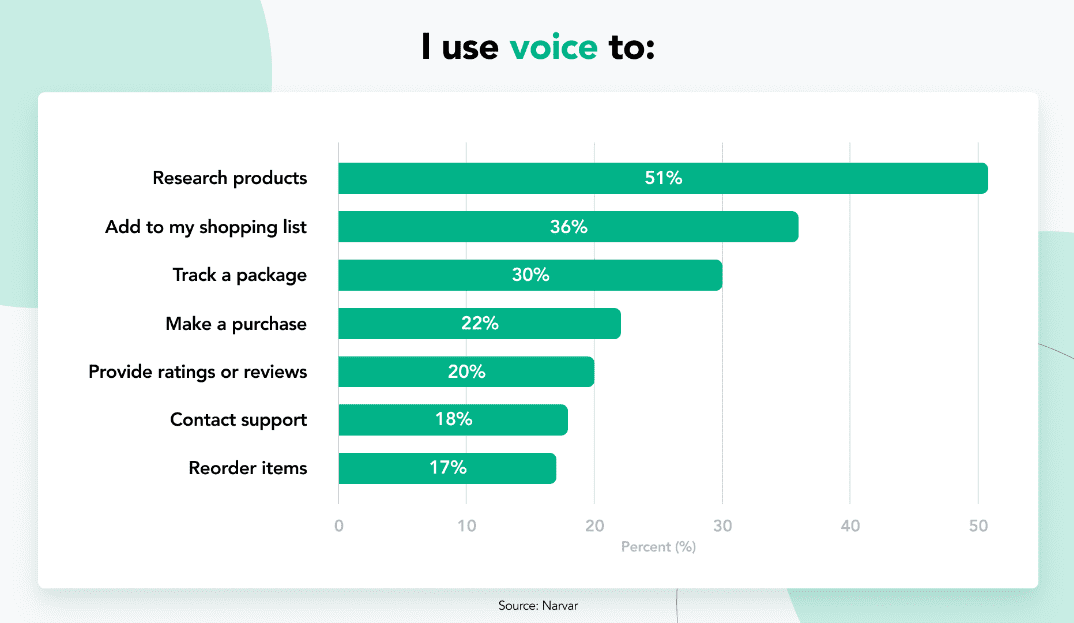
Source
60. Nearly 11.5% of smart speaker owners, or around 5.5 million U.S. adults, make purchases through voice commands every month.
70. 52% of smart speaker users are interested in getting updates on deals, sales, and promotions from brands.
71. According to Comscore, people who shop with smart speakers mainly buy health and beauty items, electronics, and household supplies.
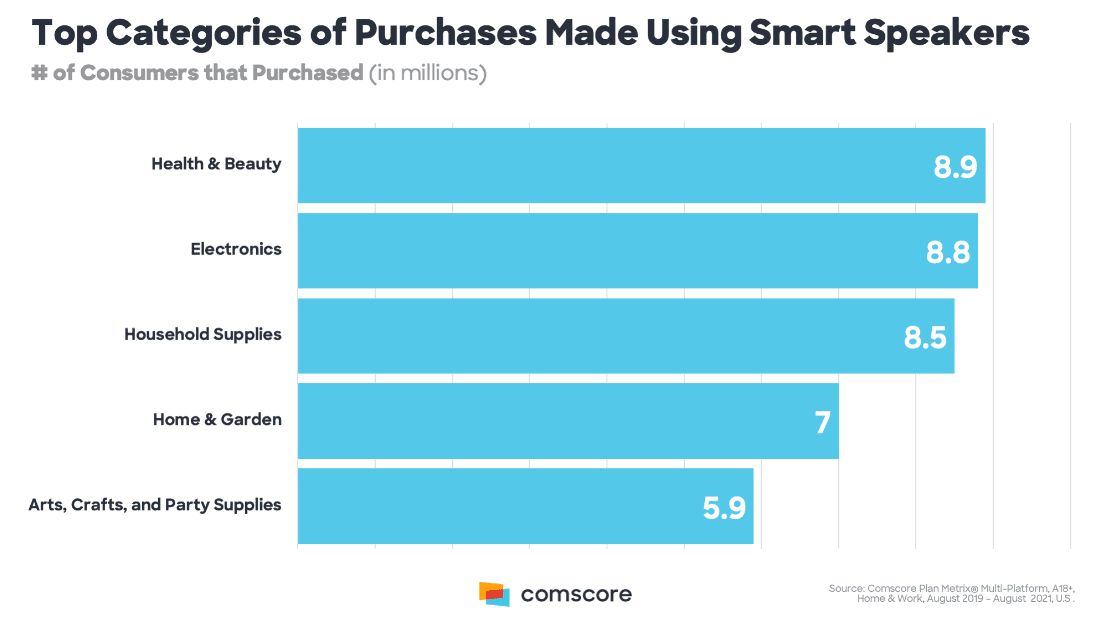
Source
72. Younger millennials (ages 25-34) are most likely to shop by voice in the U.S., U.K., and Germany, but those aged 45-54 are close behind.
73. Voice searches for shopping terms aren’t as popular as those for playing music or setting alarms.
74. Over a third (35%) of American adults are curious about voice shopping but haven’t tried it yet.
75. 34% of people have ordered takeout using their voice assistants, while only 3% have bought clothes this way.
76. 76% of shoppers use their phones to shop online. As mobile shopping continues to grow, websites that focus on mobile optimization will have the edge.
Voice Search Devices Statistics
People are now using voice-activated assistants more than ever to make their online experience smoother and interact with digital devices in a more natural way.
Why? Because voice assistants are fast, save time, and are super convenient.
If you run a business, it’s important to consider these different assistants when planning your voice search strategy and understand how their algorithms work.
Here are some key voice search stats to guide you:
77. According to Vixen Labs, the Amazon Echo with Alexa is the most popular smart speaker in the U.S., while Apple’s Siri leads in mobile device usage, with Google Assistant close behind.
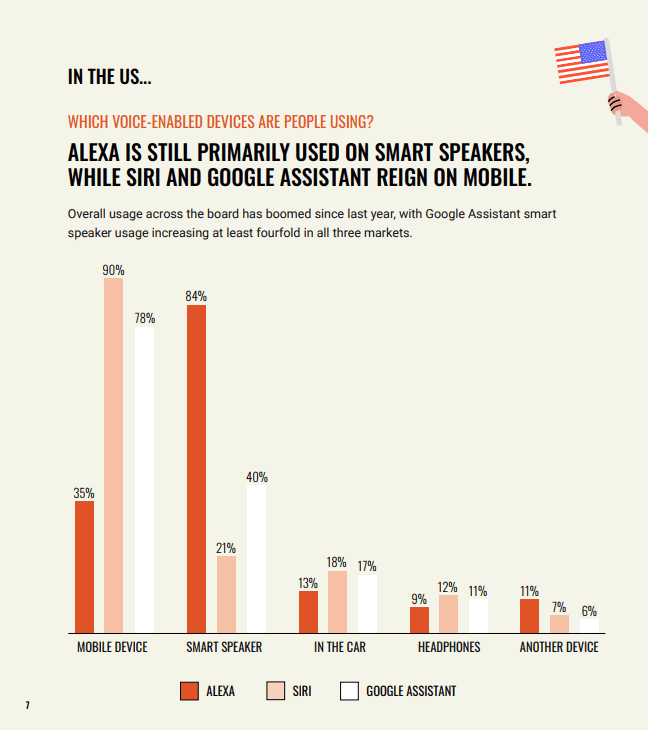
Source
78. Statista reports that after Alexa, the most popular smart speaker brands in the U.S. are Google Home, Apple HomePod, Google Nest, and Sony.
79. NPR and Edison Research found that 62% of Americans aged 18 and older use a voice assistant on any device, and 36% of Americans own smart speakers.
80. For local searches, Google Assistant relies on Google Maps, Siri uses Apple Maps (with data from Yelp), and Alexa depends on Microsoft Bing.
81. Google Assistant is used by 36% of voice search users, making it one of the most popular digital assistants. Alexa follows with 25% of users.
82. Nearly 98% of smartphone users have tried using Siri at least once, and 62% of iPhone users say they use Siri while driving.
83. A survey by Creative Strategies found that people mainly use smartphone-based voice assistants at home or in their cars. Only 6% use them in public, and very few admit to using them at work.
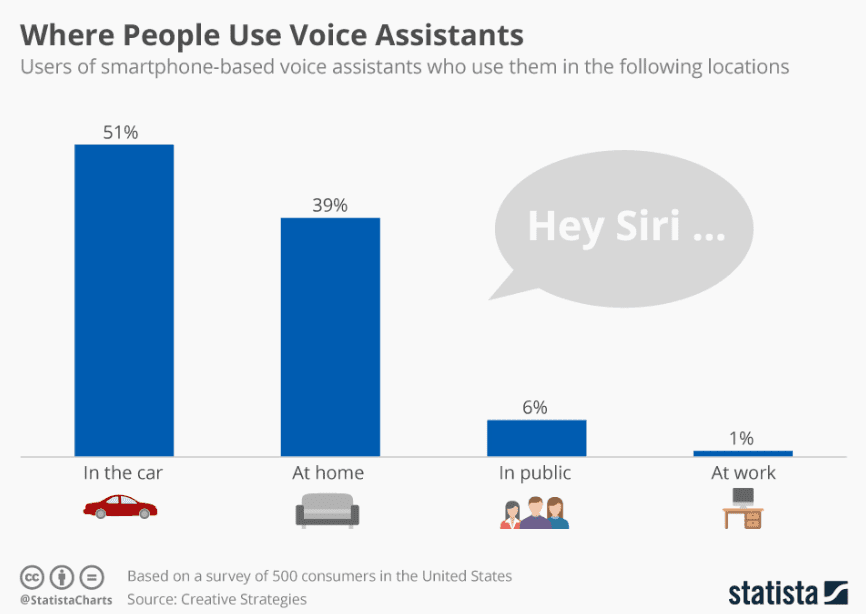
Source
84. Google Home is one of the best at answering voice search queries, with accurate responses 81% of the time.
85. Alexa is connected to over 400 million smart home devices, and users interact with these devices countless times each week. In the U.S., 71.6 million people prefer using Amazon Alexa.
86. Nearly 70% of smart speakers in the U.S. are Amazon Echo devices. By 2025, more than 130 million Amazon Echo speakers are expected to be shipped worldwide.
Voice Search Forecasts & Predictions
We’ve covered the current state of voice search. Now let’s switch gears and check out the voice search stats that give us a peek into the future.
87. eMarketer forecasts that 162.7 million Americans will use voice assistants by 2027, up from 149.1 million in 2024.
88. By 2026, 91.4 million Americans are expected to use smart speakers to ask questions.
89. A SkyQuest survey predicts the speech and voice recognition market will reach $53.94 billion by 2030, growing at a rate of 24.4% each year from 2023 to 2030.
90. About 4 in 10 U.S. consumers believe voice technology will be as good as talking to a real person within the next 5 years.
91. Young people aged 18 to 24 are quick to adopt voice search technology. In the future, voice assistants are expected to understand and respond to your mood.
Conclusion
These voice search stats show us that voice search is becoming a big part of how we use technology.
For example, by 2027, around 162.7 million Americans are expected to use voice assistants.
Also, many people will soon have digital assistants at home controlling smart devices, making everyday tasks easier.
With the voice recognition market expected to be worth over $53 billion by 2030, it’s clear that this technology is growing fast.


